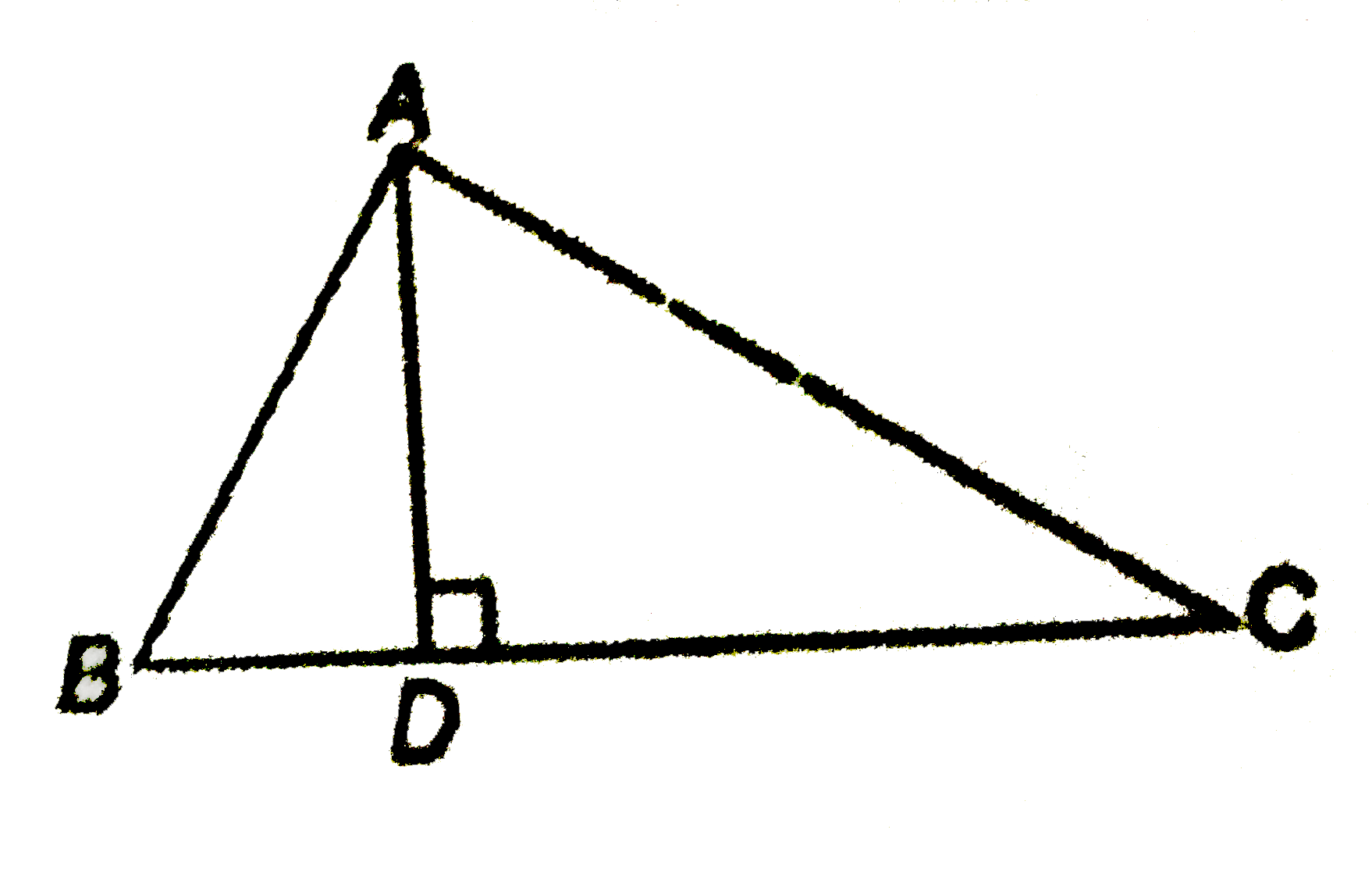In a and the length of perpendicular from B to AC is p such that If then measure
The correct Answer is:
To solve the problem step by step, we will use the properties of right triangles and trigonometric identities.
Step 1: Understand the Triangle Configuration
We are given a right triangle ΔABC where ∠B=90∘, AC=h, and the length of the perpendicular from B to AC is p. We also know that h=4p.
Step 2: Set Up the Triangle
Let D be the foot of the perpendicular from B to AC. Thus, BD=p and AD+DC=AC=h=4p.
Step 3: Define the Segments
Let AD=x and DC=4p−x. Since AB<BC, we can assume C is at the right side of B and A is at the left side.
Step 4: Use Trigonometric Ratios
In triangle BDC:
tanC=BDDC=p4p−x
In triangle BDA:
tanA=BDAD=px
Step 5: Relate the Tangents
From the definitions of tangent:
tanC=p4p−xandtanA=px
Step 6: Set Up the Equation
Using the property of tangent:
tanA⋅tanC=1
Substituting the expressions we have:
px⋅p4p−x=1
This simplifies to:
p2x(4p−x)=1
Thus:
p2=x(4p−x)
Rearranging gives:
x2−4px+p2=0
Step 7: Solve for x
Using the quadratic formula:
x=4p±√(4p)2−4⋅1⋅p22⋅1
This simplifies to:
x=4p±√16p2−4p22=4p±√12p22=4p±2√3p2=2p±√3p
Thus:
x=(2±√3)p
Step 8: Find DC
Using DC=4p−x:
DC=4p−(2±√3)p=(2∓√3)p
Step 9: Calculate tanC
Now we can find tanC:
tanC=pDC=p(2∓√3)p=12∓√3
Step 10: Find ∠C
Using the inverse tangent function:
∠C=tan−1(12∓√3)
Conclusion
To find the exact angle, we can evaluate the expression. However, we can also recognize that:
\angle C = 15^\circ \quad \text{(since \tan 15^\circ = 2 - \sqrt{3} )}
Thus, the measure of angle C is 15∘.
---
We are given a right triangle ΔABC where ∠B=90∘, AC=h, and the length of the perpendicular from B to AC is p. We also know that h=4p.
Let D be the foot of the perpendicular from B to AC. Thus, BD=p and AD+DC=AC=h=4p.
Let AD=x and DC=4p−x. Since AB<BC, we can assume C is at the right side of B and A is at the left side.
In triangle BDC:
tanC=BDDC=p4p−x
tanA=BDAD=px
From the definitions of tangent:
tanC=p4p−xandtanA=px
Using the property of tangent:
tanA⋅tanC=1
Substituting the expressions we have:
px⋅p4p−x=1
This simplifies to:
p2x(4p−x)=1
Thus:
p2=x(4p−x)
Rearranging gives:
x2−4px+p2=0
Using the quadratic formula:
x=4p±√(4p)2−4⋅1⋅p22⋅1
This simplifies to:
x=4p±√16p2−4p22=4p±√12p22=4p±2√3p2=2p±√3p
Thus:
x=(2±√3)p
Using DC=4p−x:
DC=4p−(2±√3)p=(2∓√3)p
Now we can find tanC:
tanC=pDC=p(2∓√3)p=12∓√3
Using the inverse tangent function:
∠C=tan−1(12∓√3)
To find the exact angle, we can evaluate the expression. However, we can also recognize that:
\angle C = 15^\circ \quad \text{(since \tan 15^\circ = 2 - \sqrt{3} )}
Topper's Solved these Questions
- PROPERTIES AND SOLUTION OF TRIANGLES BOOK - ARIHANT MATHS ENGLISHCHAPTER - PROPERTIES AND SOLUTION OF TRIANGLES EXERCISE - PROPERTIES AND SOLUTIONS OF TRIANGLES EXERCISE 7 : SUBJECTIVE TYPE QUESTIONS
10 Videos
- PROPERTIES AND SOLUTION OF TRIANGLES BOOK - ARIHANT MATHS ENGLISHCHAPTER - PROPERTIES AND SOLUTION OF TRIANGLES EXERCISE - Exercise (Questions Asked In Previous 13 Years Exam)
21 Videos
- PROPERTIES AND SOLUTION OF TRIANGLES BOOK - ARIHANT MATHS ENGLISHCHAPTER - PROPERTIES AND SOLUTION OF TRIANGLES EXERCISE - PROPERTIES AND SOLUTIONS OF TRIANGLES EXERCISE 6 : SINGLE INTEGER ANSWER TYPE QUESTIONS
1 Videos
- PRODUCT OF VECTORSBOOK - ARIHANT MATHS ENGLISHCHAPTER - PRODUCT OF VECTORSEXERCISE - Exercise (Questions Asked In Previous 13 Years Exam)
51 Videos
- SEQUENCES AND SERIESBOOK - ARIHANT MATHS ENGLISHCHAPTER - SEQUENCES AND SERIESEXERCISE - Exercise (Questions Asked In Previous 13 Years Exam)
38 Videos
Similar Questions
In the ΔABC,AB=a,AC=candBC=b, then
View SolutionIf −−→AB=→band−−→AC=→c then the length of the perpendicular from A to the line BC is
View SolutionConstruct a ΔABC in which BC = 4.2 cm, AB = 4.6 cm and the altitude from B to AC is 3 cm.
View SolutionConstruct a ΔABC in which AB = 4 cm, AC = 5 cm and the altitude from A to BC is 2.5 cm.
View SolutionIn ΔABC,∠B=∠C. Prove the perpendiculars from the mid-point of BC to AB and AC are equal.
View SolutionABC is a triangle in which AB = AC = 4 cm and ∠A=90∘. Calculate:
the length of perpendicular from A to BC.
View SolutionIn the figure, AD is perpendicular to BC, prove that AB+AC>2AD.

View SolutionAB, AC are tangents to a parabola y2=4ax;p1,p2,p3 are the lengths of the perpendiculars from A, B, C on any tangents to the curve, then p2,p1,p3 are in:
View SolutionAB, AC are tangents to a parabola y2=4ax;p1,p2,p3 are the lengths of the perpendiculars from A, B, C on any tangents to the curve, then p2,p1,p3 are in:
View SolutionIn a acute angled triangle ABC, proint D, E and F are the feet of the perpendiculars from A,B and C onto BC, AC and AB, respectively. H is orthocentre. If sinA=35andBC=39, then find the length of AH
View Solution
